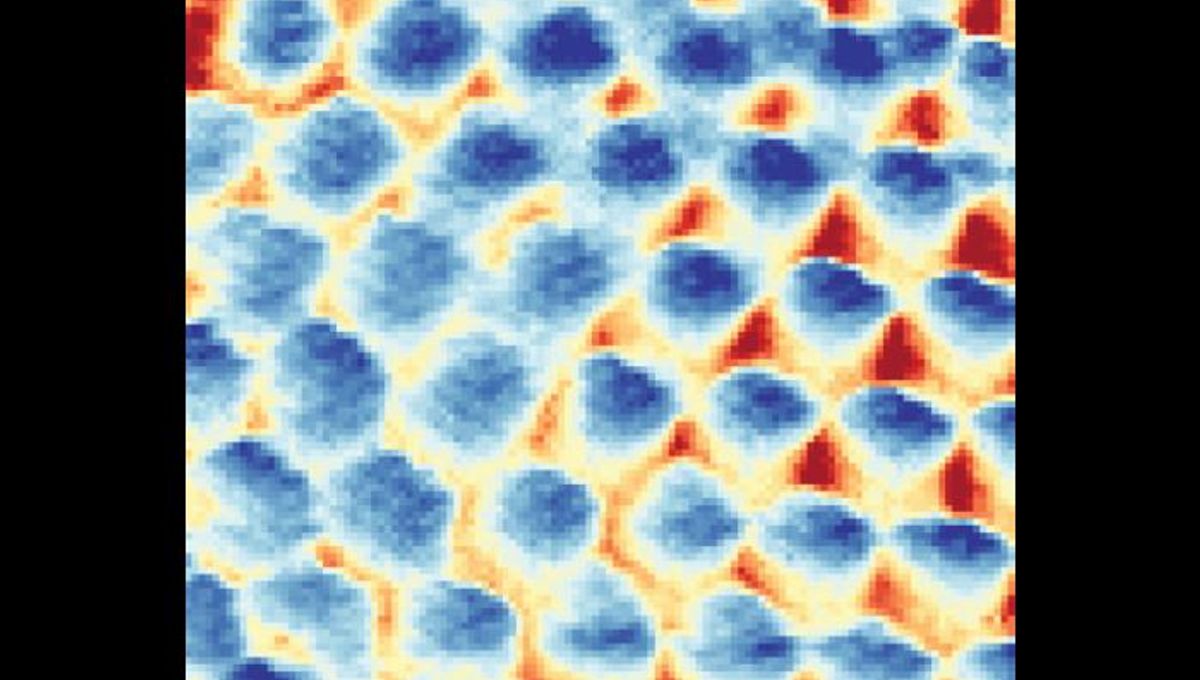
For the first time, an exotic material known as a Wigner crystal formed solely from electrons has been visualized. These impossible-sounding crystals had been claimed before, but never confirmed directly. As well as proving its existence, the images revealed unexpected aspects of the strange crystal’s nature.
Materials are composed of protons and electrons, as well as neutrons, because the attraction between them is needed for stability. However, in the 1930s, Eugene Wigner predicted that repulsion can do just as good a job as attraction in maintaining order, under the right circumstances. You can draw your own conclusions as to whether that is true in human affairs – but ninety years later, we finally know that Wigner was right about the structure of a crystal lattice.
Without intervening protons to attract them, electrons will try to get as far apart as possible. Under most circumstances, this leads them to fly apart. However, if some way can be found to maintain the density of electrons, they will arrange themselves at regular intervals to maintain as much distance as possible from each other.
Imagine a group of people who don’t like each other trapped together in a room. They want to get further away from the person on their left, but that would mean getting closer to the one on their right, so they maintain a rigid order: ie a crystal.
Theoreticians proposed so-called Wigner crystals should exist when the electric potential energy between the electrons is more than 40 times larger than their kinetic energy. Since kinetic energy can be reduced with a combination of low temperatures and a suitable magnetic field, this is testable.
Classical Wigner crystals were created in the 1970s by spraying electrons on a helium surface. However, these electrons are so distant from each other that they are more like isolated particles, and therefore not particularly interesting. Physicists are much more excited about using quantum behavior to pack an electron crystal closely enough that the electrons show wave-like cohesion.
By trapping electrons in semiconductor layers just a few atoms thick, physicists created what were suspected to be Wigner crystals, but had trouble proving it. The electrons in these cases respond to magnetic fields in ways theory suggests a Wigner crystal should, but everything has been happening on too small a scale to see. Moreover, it’s possible crystal imperfections could produce similar behavior.
“There are literally hundreds of scientific papers that study these effects and claim that the results must be due to the Wigner crystal,” Princeton University’s Professor Ali Yazdani said in a statement. “But one can’t be sure, because none of these experiments actually see the crystal.”
By joining carbon atoms in two graphene sheets as consistently as possible, Yazdani and colleagues reduced the danger of imperfections producing Wigner-like behavior. They then ran a scanning tunneling microscope (STM) over the material to confirm their work.
Just by changing the density, you can initiate this phase transition and find electrons spontaneously form into an ordered crystal.
Yen-Chen Tsui
“Our group has been able to make unprecedentedly clean samples that made this work possible,” Yazdani said. “With our microscope we can confirm that the samples are without any atomic imperfection in the graphene atomic lattice or foreign atoms on its surface over regions with hundreds of thousands of atoms.”
The sheets were then cooled to less than a degree above absolute zero and placed in a magnetic field at right angles to the sample, creating an electron gas one electron thick between the graphene sheets.
“In our experiment, we can image the system as we tune the number of the electrons per unit area,” said graduate student Yen-Chen Tsui. “Just by changing the density, you can initiate this phase transition and find electrons spontaneously form into an ordered crystal.”
When the densities are low, the forces from neighboring electrons are small enough that other factors take over, and the electrons arrange themselves chaotically. However, as the electrons get squeezed together their repulsion forces them to make an ordered lattice, which becomes an electron liquid when either the density or temperature is increased further.
The transition from crystal to liquid could be visualized with the STM, and Tsui said. “Our work provides the first direct images of this crystal. We proved the crystal is really there and we can see it.”
The crystal has a triangular configuration, and while it can be tuned as the density is adjusted, it turned out that repulsion alone keeps it stable over a wide range of conditions, contrary to expectations.
One of the key features of quantum mechanics is that subatomic particles like electrons exist as a probability curve over a range of positions, rather than having a precise location. This range – known as the zero-point motion of the electrons because it occurs without elevated energy levels – creates a blurriness in the crystal’s electrons’ location when observed.
The team was able to measure the extent of this blurriness and Yazdani said; “It turns out this quantum motion covers a third of the distance between them, making the Wigner crystal a novel quantum crystal.”
The description of the first Wigner crystal visualization is published open access in the journal Nature.
Source Link: First Visualization Of A Quantum Electron Crystal Finally Proves They Exist